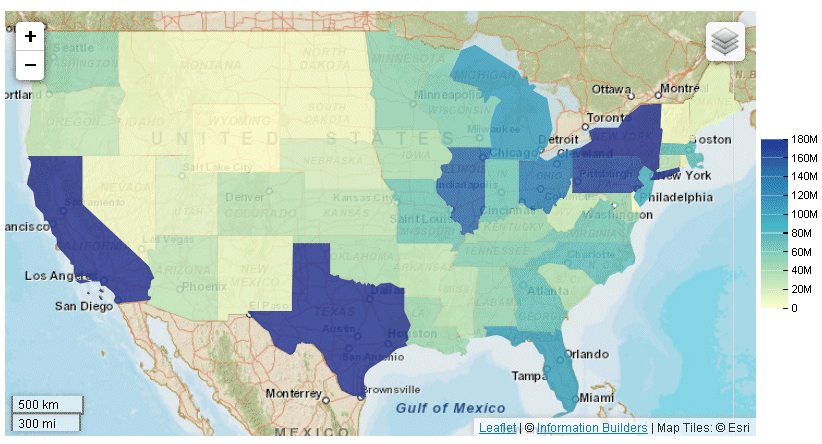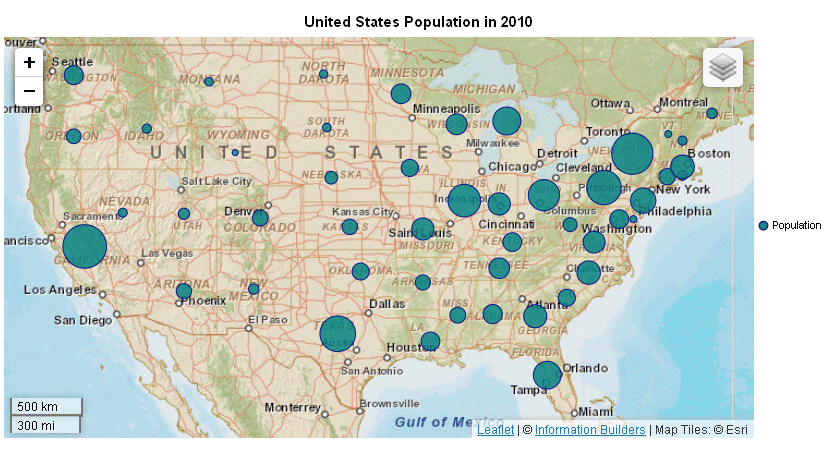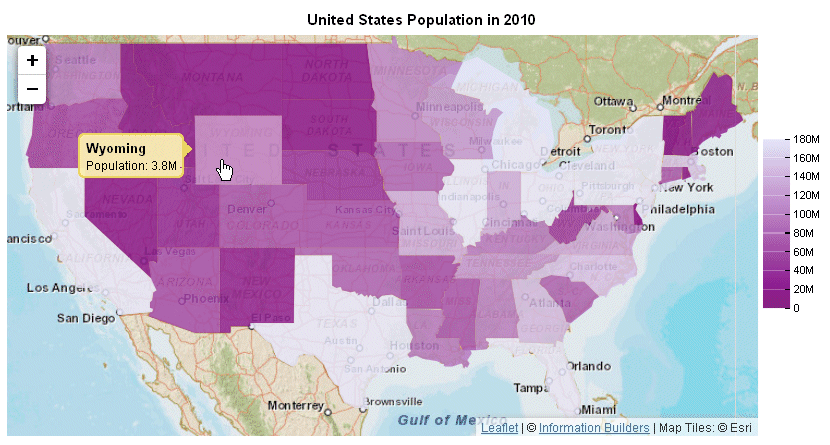Incorporating Additional Chart Properties in a Map Chart
You can use some of the general chart properties, as
well as properties specific to heatmap and bubble charts, to adjust
your chart output.
xAdjusting the Heat Scale on Choropleth Maps
You can use the yaxis:colorScale
property to define colors for your choropleth map. This property
is not part of mapProperties, it is an axis property. You can list
any number of colors, using color names, rgb values, or hex values.
For example, the following code defines a red, white, and blue color
scale:
yaxis: {
colorScale: colors:{'#C4161C', 'white', 'rgb(0,0,255)'}
}For information, see Defining the Color Scale in a Treemap, Heatmap, or Tagcloud Chart.
Example: Adding a Heat Scale Legend to a Choropleth Chart
The following request against the statepop
data source makes the legend visible:
GRAPH FILE STATEPOP
SUM POPULATION
BY STATE
ON GRAPH PCHOLD FORMAT JSCHART
ON GRAPH SET LOOKGRAPH CHOROPLETH
ON GRAPH SET STYLE *
*GRAPH_JS
legend: {visible:true},
mapProperties: {
engine: 'leaflet',
leaflet: {
initPos: {
center: [37.8, -96],
level: 4
},overlayLayers: [{
title: 'United States of America',
dataLookup: 'properties.state_name',
layerInfo: {
maxZoom: -1,
minZoom: -1,
type: 'regions'
},
type: 'tdg',
url: function(){ return tdgchart.getScriptPath() + 'map/US.json'}
}],
controls: [
{control: 'L.Control.Layers'},
{
control: 'L.Control.Scale',
options: {
imperial: true,
metric: true }
}
],baselayers: [{
title: "ArcGIS_World_Street_Map",
layerInfo: {
maxZoom: 17,
minZoom: 0,
attribution: function(){ return "&|copy; <a target='_blank' href='http://www.InformationBuilders.com'>Information Builders</a> | " +
"Map Tiles: &|copy; Esri";}
},
url: function(){ return 'http://services.arcgisonline.com/ArcGIS/rest/services/World_Street_Map/MapServer/tile/{z}/{y}/{x}';}
}]
}
},
*END
ENDSTYLE
ENDThe output now has a legend
that defines the color for each population range:

xAdjusting the Hover Color
As with any other type of chart, you can define a color
or opacity setting for adjusting the display of a marker when the
mouse hovers over it. To do this, you use the MouseOverIndicator
property,
For example, the following property makes
the selected chart area or marker 70% opaque when the mouse hovers
over it:
mouseOverIndicator: {
color: '70%'
}The following property makes the marker
yellow when the mouse hovers over it:
mouseOverIndicator: {
color: 'yellow'
}For more information, see Formatting the Mouse Over Indicator (mouseOverIndicator).
xAdjusting the Color and Size of Bubbles on Bubblemaps
You can use series-specific properties to control the
color and border of bubbles on any bubble chart, including a bubblemap.
For example, the following code makes the markers red with transparent
borders:
series: [
{series:0, color: 'red', marker:{border: {color: 'transparent'}}}
]For information about marker properties, see Defining the Size, Border, Color, Shape, and Rotation of Series Markers.
In addition, you can control the size of bubble markers on a
bubblemap or a bubble chart using the bubbleMarker: maxSize property.
This property is not part of the mapProperties block, it is a property
of bubble charts.
x
Syntax: How to Set the Maximum Size of Bubbles on a Bubblemap
Use the following property to specify
the radius of the largest bubble:
bubbleMarker: {maxSize: size}where:
- size
Determines the radius of the largest bubble. It can be a
number of pixels or a percent string enclosed in single quotation
marks and including a percent symbol (from '1%' to '100%'). If you
use a percent string, it takes the minimum of the width and height
of the chart container and then calculates the percent.
Example: Formatting Bubbles on a Bubblemap
The
following request against the statepop data source generates a bubblemap.
Using the bubbleMarker property, it sets a maximum size for the
bubbles. Using the series marker properties, it makes the bubbles
teal with a navy border and defines a label to appear in the legend.
The title property assigns a title to the chart:
GRAPH FILE STATEPOP
SUM POPULATION
BY STATE
ON GRAPH PCHOLD FORMAT JSCHART
ON GRAPH SET LOOKGRAPH BUBBLEMAP
ON GRAPH SET STYLE *
*GRAPH_JS
mapProperties: {
engine: 'leaflet',
leaflet: {
initPos: {
center: [37.8, -96],
level: 4
},overlayLayers: [{
title: 'United States of America',
dataLookup: 'properties.state_name',
layerInfo: {
maxZoom: -1,
minZoom: -1,
type: 'regions'
},
type: 'tdg',
url: function(){ return tdgchart.getScriptPath() + 'map/US.json'}
}],
controls: [
{control: 'L.Control.Layers'},
{
control: 'L.Control.Scale',
options: {
imperial: true,
metric: true }
}
],baselayers: [{
title: "ArcGIS_World_Street_Map",
layerInfo: {
maxZoom: 17,
minZoom: 0,
attribution: function(){ return "&|copy; <a target='_blank' href='http://www.InformationBuilders.com'>Information Builders</a> | " +
"Map Tiles: &|copy; Esri";}
},
url: function(){ return 'http://services.arcgisonline.com/ArcGIS/rest/services/World_Street_Map/MapServer/tile/{z}/{y}/{x}';}
}]
}
},
legend: {visible:true},bubbleMarker: {maxSize: '10%' },
series:[{series:0, marker:{color: 'teal', border:{color: 'navy', width: 1}},label: 'Population'}],
title: {visible: true, text: 'United States Population in 2010'} ,
*END
ENDSTYLE
ENDThe output is:

xDefining Colors and Tooltips on Choropleth Charts
The following request against
the statepop data source generates a choropleth with color scale
consisting of purple and lavender. It also defines automatic HTML-style
tooltips:
GRAPH FILE STATEPOP
SUM POPULATION
BY STATE
ON GRAPH PCHOLD FORMAT JSCHART
ON GRAPH SET LOOKGRAPH CHOROPLETH
ON GRAPH SET STYLE *
*GRAPH_JS
mapProperties: {
engine: 'leaflet',
leaflet: {
initPos: {
center: [37.8, -96],
level: 4
},overlayLayers: [{
title: "United States of America",
dataLookup: "properties.state_name",
layerInfo: {
maxZoom: -1,
minZoom: -1,
type: 'regions'
},
type: 'tdg',
url: function(){ return tdgchart.getScriptPath() + 'map/US.json'}
}],
controls: [
{control: L.Control.Layers},
{
control: L.Control.Scale,
options: {
imperial: true,
metric: true
}
}
],baselayers: [{
title: "ArcGIS_World_Street_Map",
layerInfo: {
maxZoom: 17,
minZoom: 0,
attribution: function(){ return "&|copy; <a target='_blank' href='http://www.InformationBuilders.com'>Information Builders</a> | " +
"Map Tiles: &|copy; Esri";}
},
url: function(){ return 'http://services.arcgisonline.com/ArcGIS/rest/services/World_Street_Map/MapServer/tile/{z}/{y}/{x}';}
}]
}
},
legend:{visible:true},
title: {visible: true, text: 'United States Population in 2010'},yaxis: {colorScale: {colors: ['purple', 'lavender'] }},
htmlToolTip: {enabled: true, snap:true},
series: [{series: 'reset', tooltip:'auto'}] ,
*END
ENDSTYLE
ENDThe output is:



